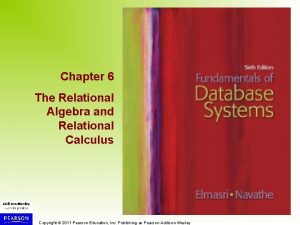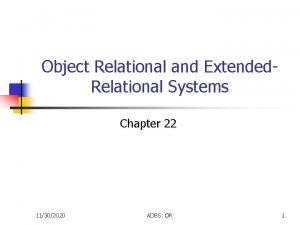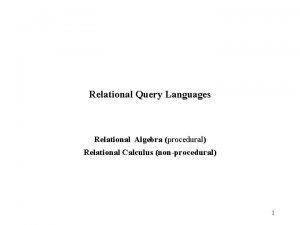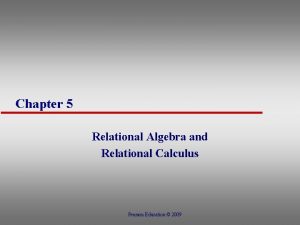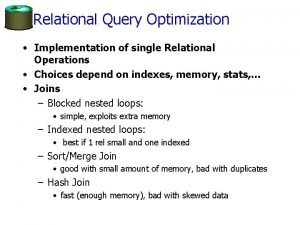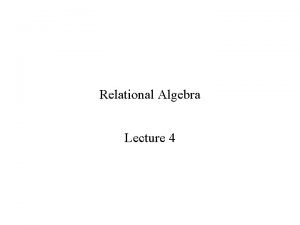Implementation of Relational Operations Selection 1 Relational Operations









- Slides: 9

Implementation of Relational Operations: Selection 1

Relational Operations v We will consider how to implement: – Selection ( ) Selects a subset of rows from relation. – Join ( ) Allows us to combine two relations. v Since each op returns a relation, ops can be composed! After we cover the operations, we will discuss how to optimize queries formed by composing them. 2

Schema for Examples Sailors (sid: integer, sname: string, rating: integer, age: real) Reserves (sid: integer, bid: integer, day: dates, rname: string) Similar to old schema; rname added for variations. v Reserves: v – Each tuple is 40 bytes long, 100 tuples per page, 1000 pages. v Sailors: – Each tuple is 50 bytes long, 80 tuples per page, 500 pages. 3

Simple Selections SELECT FROM WHERE * Reserves R R. rname < ‘C%’ Of the form v Size of result approximated as size of R * reduction factor; we will consider how to estimate reduction factors later. v With no index, unsorted: Must essentially scan the whole relation; cost is M (#pages in R). v With an index on selection attribute: Use index to find qualifying data entries, then retrieve corresponding data records. (Hash index useful only for equality selections. ) v 4

Using an Index for Selections v Cost depends on # of qualifying tuples and clustering. – Cost of finding qualifying data entries (typically small) plus cost of retrieving records (could be large w/o clustering). – In example, assuming uniform distribution of names, about 10% of tuples qualify (100 pages, 10000 tuples). With a clustered index, cost is little more than 100 I/Os; if unclustered, up to 10000 I/Os! v Important refinement for unclustered indexes: 1. Find qualifying data entries. 2. Sort the rids of the data records to be retrieved. 3. Fetch rids in order. This ensures that each data page is looked at just once (though # of such pages likely to be higher than with clustering). 5

General Selection Conditions * (day<8/9/94 AND rname=‘Paul’) OR bid=5 OR sid=3 Such selection conditions are first converted to conjunctive normal form (CNF): (day<8/9/94 OR bid=5 OR sid=3 ) AND (rname=‘Paul’ OR bid=5 OR sid=3) v We only discuss the case with no ORs (a conjunction of terms of the form attr op value). v An index matches (a conjunction of) terms that involve only attributes in a prefix of the search key. v – Index on <a, b, c> matches a=5 AND b= 3, but not b=3. 6

Two Approaches to General Selections v First approach: Find the most selective access path, retrieve tuples using it, and apply any remaining terms that don’t match the index: – – – Most selective access path: An index or file scan that we estimate will require the fewest page I/Os. Terms that match this index reduce the number of tuples retrieved; other terms are used to discard some retrieved tuples, but do not affect number of tuples/pages fetched. Consider day<8/9/94 AND bid=5 AND sid=3. A B+ tree index on day can be used; then, bid=5 and sid=3 must be checked for each retrieved tuple. Similarly, a hash index on <bid, sid> could be used; day<8/9/94 must then be checked. 7

Intersection of Rids v Second approach (if we have 2 or more matching indexes that use Alternatives (2) or (3) for data entries): – – Get sets of rids of data records using each matching index. Then intersect these sets of rids (we’ll discuss intersection soon!) Retrieve the records and apply any remaining terms. Consider day<8/9/94 AND bid=5 AND sid=3. If we have a B+ tree index on day and an index on sid, both using Alternative (2), we can retrieve rids of records satisfying day<8/9/94 using the first, rids of recs satisfying sid=3 using the second, intersect, retrieve records and check 8 bid=5.

Summary A virtue of relational DBMSs: queries are composed of a few basic operators; the implementation of these operators can be carefully tuned (and it is important to do this!). v Many alternative implementation techniques for each operator; no universally superior technique for most operators. v For Selection: v – File scan: always works – Index: if one matches a condition – Disjunctive queries: can be difficult; use UNION or bitmaps 9
 Relational algebra and relational calculus
Relational algebra and relational calculus Object relational and extended relational databases
Object relational and extended relational databases Relational algebra and calculus
Relational algebra and calculus Relational algebra and relational calculus
Relational algebra and relational calculus Relational calculus
Relational calculus Difference between continuous and discontinuous variation
Difference between continuous and discontinuous variation Two way selection and multiway selection
Two way selection and multiway selection Artificial selection vs natural selection
Artificial selection vs natural selection Natural selection vs artificial selection
Natural selection vs artificial selection Mass selection and pure line selection
Mass selection and pure line selection
